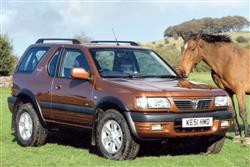WILD FRONTERA (some text hidden) --NONE--
BY JONATHAN CROUCH
Introductionword count: 108
Vauxhall launched these three and five-door off-roaders in late 1991 into a market deep in recession, yet they were immediately a smash hit. Sales of GTi-style cars had crashed after insurance companies pushed premiums through the roof. Suddenly, all those twenty-something buyers needed a new type of vehicle to turn their attentions to and they found it in the Frontera. Vauxhall didn't exactly create the off-road/leisure vehicle market but they certainly made it more accessible. The Frontera comes in two forms that appeal to two different buyer groups. The Tonka-toy looks of the three-door are as irresistible to as many people as the five-door junior Range Rover styling.
Modelsword count: 47
Models Covered: First Generation (1991-1998)3 & 5-door, 2.0, 2.2, 2.4, 2.3, 2.5 & 2.8 turbo diesels [Sport, Sport Soft-top, Sport S, 16v, I, TD, TD Sport, TD Sport S] Second Generation (1998-to date)3 & 5-door, 2.0, 2.2, 2.2 turbo diesel, 3.2V6 [Sport, Sport RS, Estate, Estate Limited]
Historyword count: 311
The Frontera, though assembled in Luton, is actually a rebadged Isuzu design, but more so than the Isuzu Trooper/Vauxhall Monterey (RIP) twins. The engines are a successful mix of European and Japanese, like the styling. There were three models at the October 1991 launch - a 2.0-litre three-door Sport, a 2.4-litre five-door and a 2.3-litre turbo diesel five-door. The first change came in September 1993 when the 2.0-litre engine gained fuel injection. The model retained the Sport name but gained electric mirrors and windows. Apart from a couple of very limited-run special editions and a short-lived but desirable open-topped Sport version, there were no further changes until April 1995 when new engines arrived, including a 2.2 and a 2.8-litre turbo diesel. For the 1997 model year, driver and passenger airbags became available and the 2.8-litre turbo diesel engine was swapped for a 2.5 with more power and torque. A new dashboard lifted the appearance of the interior and addressed all the ergonomic criticisms that had been thrown at it since the 1991 launch. The line-up was replaced by an all-new range (including a V6 derivative) in October 1998. This featured more modern styling and a new 2.2-litre (Opel rather than Isuzu) direct injection diesel engine. The 2.2-litre petrol engine from the old model was retained and the 3.2-litre V6 from the (now defunct) Monterey was borrowed for the replacement flagship Estate model. This 3.2-litre engine was also added to the three-door range in October 2000 in the Sport RS model. Late 2001 saw further changes to the Frontera line up, with a V-shaped grille, clear light lenses and new designs of alloy wheels adopted. The Olympus models, previously special editions, were subsumed into the mainstream range whilst the 3.2-litre engine was now offered in both three and five door body styles. By early 2004 it was all up for the Frontera.
What You Getword count: 94
You don't get full-time four-wheel drive. No, these are Suzuki Vitara-style off-roaders. Most of the time, the Frontera is a rear-wheel drive machine but you can change to four-wheel drive quickly enough. The main advantage with cars of this type is the ability to see over the cars queued ahead of you and to anticipate hold-ups. The interiors are a bit boring to look at but are usually full of equipment to make the journey less tiring. Many cars have electric windows, central locking and a sunroof as well as a good sound system.
To see the full road test text contact us on 0330 0020 227
Pictures (high res disabled)


|

|

| |||

|

|

|
Scoring (subset of scores)
Category: Crossover or SUV 4x4s
| Performance | |
| Handling | |
| Comfort | |
| Space | |
| Styling, Build, Value, Equipment, Depreciation, Handling, Insurance and Total scores are available with our full data feed. | |



